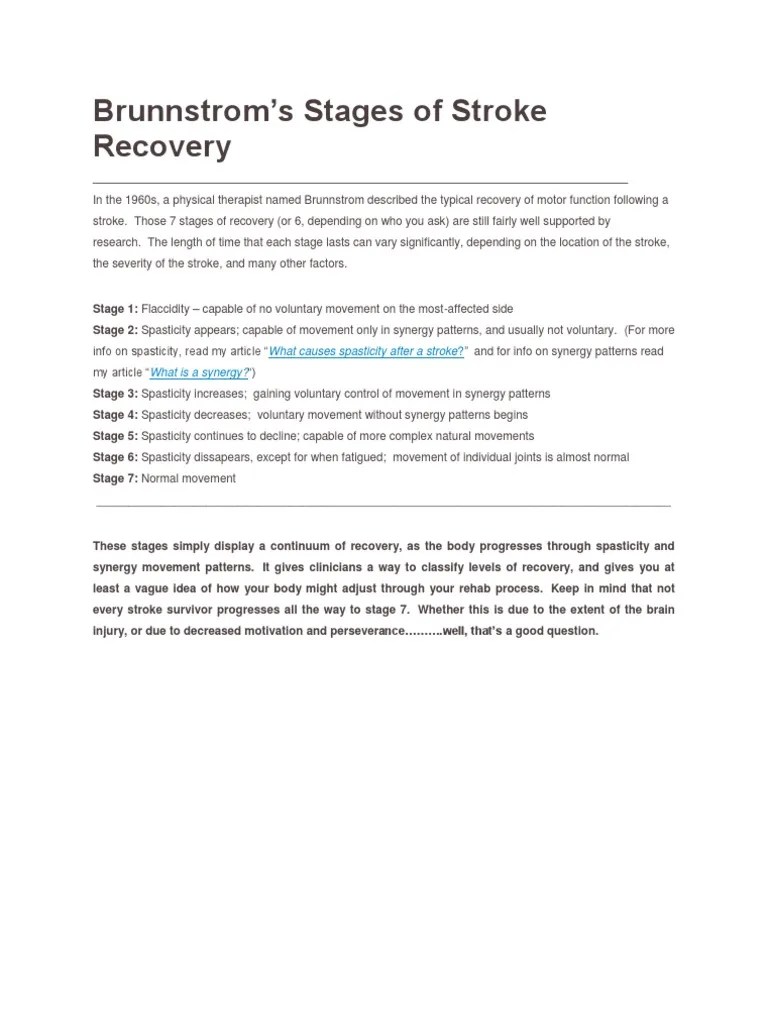Most treatments offered to stroke patients will focus on trying to inhibit atypical muscle synergies and movements. The flexor synergy and the extensor synergy. Flexed ue flexion synergy patternselbow:forearm: There is no specialised training available in this approach. On the other hand, these stages teach patients how to use those synergy patterns to their advantage.
Web 3.1.1 brunnstrom stages of motor recovery the seven brunnstrom stages of motor recovery (see table below for more details) 1. Use of such procedure is temporary. Web synergy patterns are not exclusive to people who have had a stroke; The methods to train synchronization of muscles may diminish the deviated movement augmenting. To combine them into more functional movement patterns.
The flexor synergy and the extensor synergy. Think about the movement that happens when you try to touch the ear on the same side of your body. This approach highly focuses synergic pattern of spastic muscles on the recovery of stroke patients through various stages. There is no specialised training available in this approach. Web 3.1.1 brunnstrom stages of motor recovery the seven brunnstrom stages of motor recovery (see table below for more details) 1.
It was developed by the swedish physical therapist signe brunnström , and emphasises the synergic pattern of movement which develops during recovery. You might note that for a stroke patients hip flexion, hip abduction, hip external rotation, knee flexion, ankle dorsiflexion and inversion and toe dorsiflexion will. Abduction and external rotation elbow: Web reciprocal movements need to be encouraged early, once synergy patterns are voluntary, what should the next step be. The brunnstrom approach, on the other hand, teaches patients how to use the abnormal synergy patterns to their advantage. The principle is used to drive movement. To combine them into more functional movement patterns. A good example of this will be the flexor synergy pattern for the lower limb; Web upper limb flexor synergy: Synergistic movements may be elicited voluntarily. The synergy patterns that people with neurological patients move in is still used today in treatment. Web evaluate practically basic limb synergies. Web 4.1.1 brunnstrom stages of motor recovery the seven brunnstrom stages of motor recovery (see table below for more details) 1. The methods to train synchronization of muscles may diminish the deviated movement augmenting. Following a stroke, survivors experience various physical and cognitive.
They May Also Be Seen In Healthy Persons.
Web the brunnstrom approach sets out a sequence of stages of recovery from hemiplegia after a stroke. Web synergy patterns are not exclusive to people who have had a stroke; Web there are two typical synergy patterns in this stage: Most treatments for stroke patients still focus on trying to inhibit abnormal movements and muscle synergies.
Web Upper Limb Flexor Synergy:
A good example of this will be the flexor synergy pattern for the lower limb; Web this causes the muscle synergies to move in abnormal patterns. Complex movement returns stage 6: Web watch brunnstrom therapy lectures (premium content) only on physioclassroom channel and learn more about treatment techniques and strategies to treat hemiplegia | stroke paralysis patients.
Web 4.1.1 Brunnstrom Stages Of Motor Recovery The Seven Brunnstrom Stages Of Motor Recovery (See Table Below For More Details) 1.
After brain insult, a set of deviated movement pattern emerges in the affected limb. Spasticity in muscles increases during the third stage, reaching its peak. Web recovery from a stroke is a gradual process that looks different for each person. Based on observations of recovery following a stroke, this approach makes use of associated reactions, tonic reflexes and the development of basic limb synergies to facilitate movements.
You Might Note That For A Stroke Patients Hip Flexion, Hip Abduction, Hip External Rotation, Knee Flexion, Ankle Dorsiflexion And Inversion And Toe Dorsiflexion Will.
Web patients exhibit only few stereotypic movement patterns: Synergistic movements may be elicited voluntarily. The synergy patterns that people with neurological patients move in is still used today in treatment. Web what happens during stage 3?









